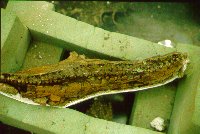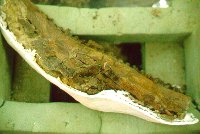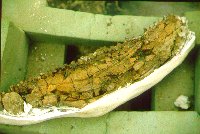Dinosaur Bone Preparation II.
The Final Product.
The Dinosaur Bone Project

The toothline on the lingual surface is now nearly complete, revealing a portion of the maxilla of a hadrosaur, probably Edmontosaurus annectens.
Photos © 1999 J. Long

Josh now is ready to tackle the underside of the specimen where the condition of the bone is much weaker. It appears that the maxilla may have been crushed, perhaps by a predator such as T. rex.
Photos © 1999 J. Long
`
The nearly completed jaw reveals the maxilla with two rows of teeth alternating along its length. Many other teeth, perhaps replacements for lost teeth, or developing batteries of teeth were found in the gumline.
Photos © 1999 J. Long


The nearly completed fragment from the proximal side. Because of Josh's careful work, we can learn a lot from the specimen. Virtually every piece of bone is in its taphonomic position in the specimen .Total time elapsed 5 weeks. More than 60 hours went into preparing this specimen.
Photos © 1999 J. Long
The nearly completed jaw from the distal side. Since this is the side exposed upwards in the burial site, it shows considerably more degradation than the distal surface. possibly some of the missing bone is due to weathering on this side. The specimen is ready for taphonomic analysis.
Photos © 1999 J. Long

Back 
 Next
Next
| |||
| |||
| ||||
| |||
| |||
Back 
 Next
Next
